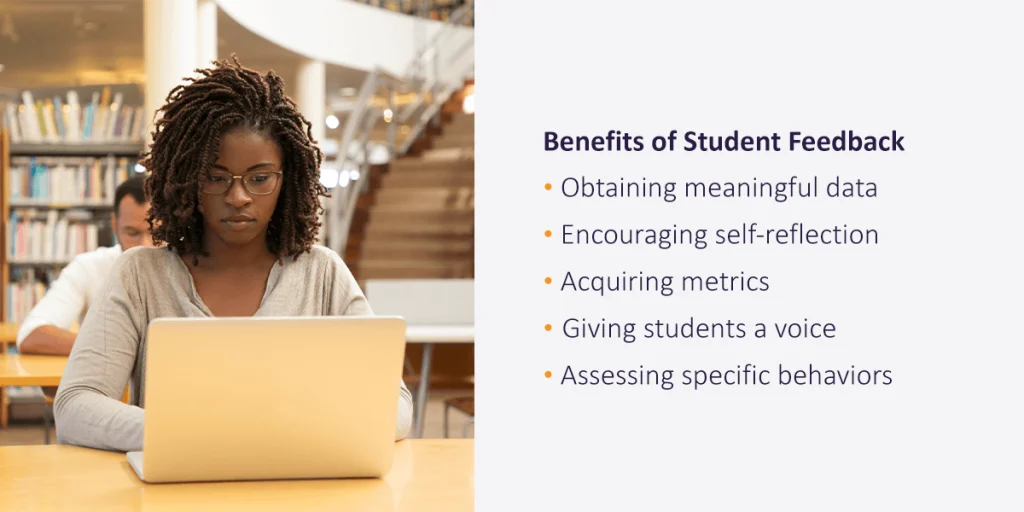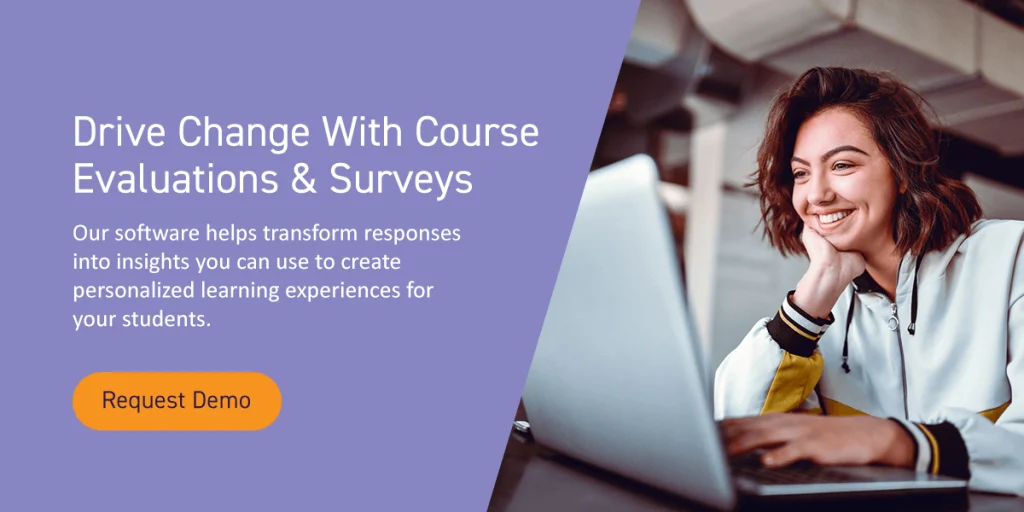Course feedback allows higher education institutions to gather insights and collect meaningful student data. You can collaborate with institution decision-makers through feedback to build an empowering curriculum that leads each student to success.
By understanding student experiences, instructors can devise a curriculum that keeps students engaged with materials and encourage them to connect with their studies. Additionally, student feedback gives insight into institutional strengths and weaknesses, effectively allowing decision-makers to set new goals, bridge gaps, and create a more rewarding student experience.
What You Need to Know About Course Feedback
Before distributing course evaluations, you should understand the purpose of obtaining the information and how to gather it effectively. Course feedback evaluations are only as effective as the questions within them. Your course evaluation feedback questions must have purpose and be concise while addressing one topic at a time.
Questions with more than one topic or confusing language can lead students to ignore questions or avoid answering truthfully. Your questions should target one objective and avoid jumping from one aspect of campus life to another. You will also want to avoid making the evaluation long, so students are inclined to finish it honestly. Consider distributing your evaluations online because more students may answer honestly without time constraints or fearing they will reveal their identity.
Additionally, your evaluations should aim to collect data that will help you reach a goal or understand why you’re missing the mark on one. You should always target surveys where they will be the most beneficial. For example, if you want to determine why a particular program has a low success rate, target evaluations of the students in that department to receive results that accurately depict that program. You should also include all your staff in the decision to target a goal. Open communication will encourage collaboration and help your institution work together to find a solution.

Benefits of Student Feedback
Implementing student course evaluations has many benefits. Your entire institution can benefit from obtaining accurate data that reflects campus perspectives and identifies where your institution can improve.
Benefits of student semester feedback could include:
- Obtaining meaningful data: When trying to set or reach initiatives, students can give insight into pain spots on your campus or in the curriculum. Students can pull from personal experience to explain where they want to see change so you can take out the guesswork.
- Encouraging self-reflection: Evaluations allow students to reflect on their efforts over the semester. They must consider what they enjoyed or disliked and can point out what you could change for future students.
- Acquiring metrics: You can use feedback to provide long-term metrics. Instructors can refer to evaluations to assess whether teaching methods are effective. They can adjust the curriculum as necessary to challenge students while keeping them engaged.
- Giving students a voice: Providing students an opportunity to use their voice tells them you care about their experiences and achievements. Students who feel connected to their education are more likely to engage with their course materials and reach success.
- Collecting and assessing information: Receiving data is essential for setting new goals and tracking progress on current ones. Obtaining information quickly will streamline the process and enable you to make decisions, implement new goals, and drive changes much sooner.
How to Apply Course Feedback
Knowing how to use course feedback can help you adjust institution initiatives and implement change on your campus. How you apply feedback can show students and staff that your institution cares about their experiences and enable you to drive change that leads to new goals.
Identify Challenges
Monitoring every student or experience is challenging for higher education institutions, with thousands of learners navigating their academics. Although instructors actively engage with students in classes, they generally don’t have access to insider information. Student evaluations allow institution decision-makers to identify pain points before they develop into significant issues.
This could involve identifying a struggling student who doesn’t know how to ask for help, gathering ideas to improve a sense of community or something else to help your students stay engaged. Some students may feel nervous about revealing personal information, but anonymous surveys can encourage them to speak about issues they otherwise would not identify.
Adjust Initiatives
Students are the best critics of higher ed institutions because they experience the campus culture, curriculum, and everyday routines. Whether your institution has set one goal or many, you should always aim to soar past them and continue making new ones. Student feedback gives you insight into whether you’re close to meeting those goals or falling behind your trajectory.
You should reflect on student feedback and make a plan of action to address their concerns and tackle the change they want to see. Your goals may often align with the expectations of your students, and you can use their input to understand where change needs to begin. You may want to adjust a goal to become more realistic or set a lofty goal that presents a worthwhile challenge. Additionally, your data can inform budgeting decisions, spark new programs, and customize learning experiences to make an engaging curriculum for every student.
Create ePortfolios
Creating ePortfolios enables students to reflect on the semester and determine what information they find valuable. You can encourage students to engage with the class materials and allow instructors to address feedback by creating opportunities for students to show what they’ve learned throughout their courses.
ePortfolios are a way to collect and engage with feedback while encouraging students to create something they can show to future employers or provide a baseline for other documents, such as a resume or job application. Instructors can use ePortfolios to determine which lessons students found the most valuable. They can also compare student feedback over multiple semesters or years. Educators can compare results and determine the most effective teaching methods or most difficult information to understand.
Drive Change With Course Evaluations & Surveys
Watermark provides solutions for higher education institutions to drive your missions and initiate change. We know what can help because we’ve been in your shoes.
We want to help you make a difference, not just check a box. Collecting data doesn’t have to be busy work. Streamline the process and get your results faster than ever. We can simplify the data reporting and collection process, so you can spend more time making meaningful changes and guiding your students to success.
Watermark Course Evaluations & Surveys turn data into actionable results. Our software helps transform responses into insights you can use to create personalized learning experiences for your students. We provide automatic results distribution so administrators, educators, and teaching assistants can analyze trends over time.
Request a demo of Course Evaluations & Surveys and turn your student feedback into actionable insights.
















































































































































































































































































































































































































